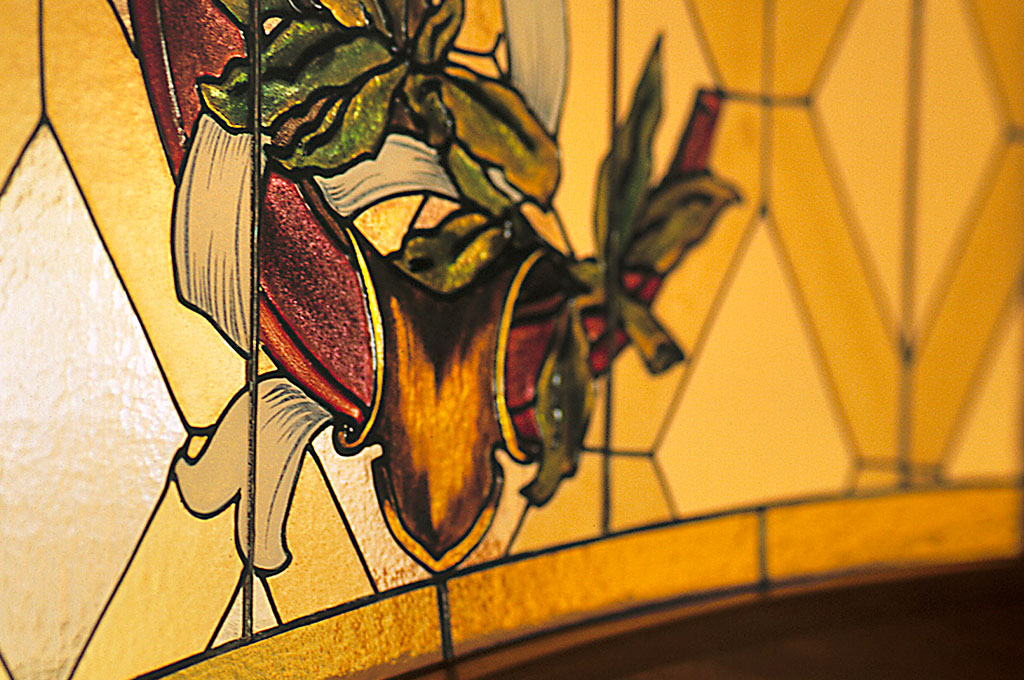A Master glassmaker, Vittorio Benvenuto came upon a long-lost technique purely chance: email tube has, in fact sunk into oblivion. The Master tells us how he has brought the technique back to life through experiments and research, and not without difficulties, while managing to restore some memorable pieces to their original splendour. Only a few marvellous example of this art are available, and the secrets involved producing them have not been handed down to us.
“This technique was very popular during the first decades of the twentieth century, as it made artistic windows less expensive. A paste that was ejected from a sort of syringe was used to frame the pieces of glass with a fine thread; transparent enamel was applied to the glasses themselves. The windows were then heated in a furnace. A few splendid examples of this technique do exist, principally by the Milan-based Corvaja & Bazzi firm, which was the main producer of these windows in Italy. However, today the chemical composition of the paste used to frame the edges of glass remains an unrevealed secret, probably because the technique is quite complicated. It is virtually impossible to find pictorial material for email tube and, at any rate, it is very difficult to paint using this technique, and to establish the right temperature for heating the windows”.
“It has taken me a lot of time and commitment to reconstruct the various phases of this technique and achieve an acceptable standard for the execution of the windows. My first encounter with email tube was during the 1980s, when I was asked to restore an accidentally broken glass door in an art nouveau-style villa near Treviso. My first look at the glass, which was made with various decorate rectangles soldered together with lead, immediately presented the difficulties involved in the task. Although I had already worked with baked enamels and grit threads, I had never come across this particular technique, so I decided to show the glass to two friends of mine who are experienced in the field of baked enamels. They had already seen windows of the kind, but had never produced any themselves. One of the problems was finding the right substitutes for the original substances that had disappeared from the market due to the fact that they were toxic and dangerous to the environment. Despite my attempts at finding satisfactory solutions and ways of applying the thread in relief so that the enamels could be contained within the threaded “frames”, I realized that all my experimenting and research would take too long, so I had to abandon the commission. But I was to be presented with another opportunity at the beginning of the 1990s. This time I was to deal with a window that ran down the entire vertical length of a staircase in another art nouveau-style villa in Treviso. The window, entirely made with the email-tube technique, depicted climbing roses, amphora, peacocks and indigo skies. I decided that this time I would go through with the commitment at all costs. I looked around for all the materials I needed, choosing Johnson& Matthey as my supplier. For 3 months I experimented, until I managed to produce the three missing glass pieces.
The owner was satisfied, but I knew I still needed to work at the technique. In 1999 I was faced with another work, a partition set within a wooden structure in a Venetian villa. The owner, who was an architect, designed full-sized cartoons for the glass, and I set out to satisfy her request with the help of Sabrina Bianco, an excellent painter. After working on the colours so as to find the exact hues and shades for the glass, we set about creating the four transom windows to be placed at the top of the partition. This was ready two years after my first approach to the job”.
“From the moment onwards, the different stages of baking the grit and enamels, as well as soldering the pieces together, were carried out smoothly, and the work was finished in January 2002. I am glad to be able to relate these experiences to other glassmaker who might be interested in this technique, as it would be a pity for such a form of Italian craftsmanship (or art…) to be lost in history. Anyone who may wish to contact me can do so at my email address. I am open to any sort of cultural exchange on the subject”.



